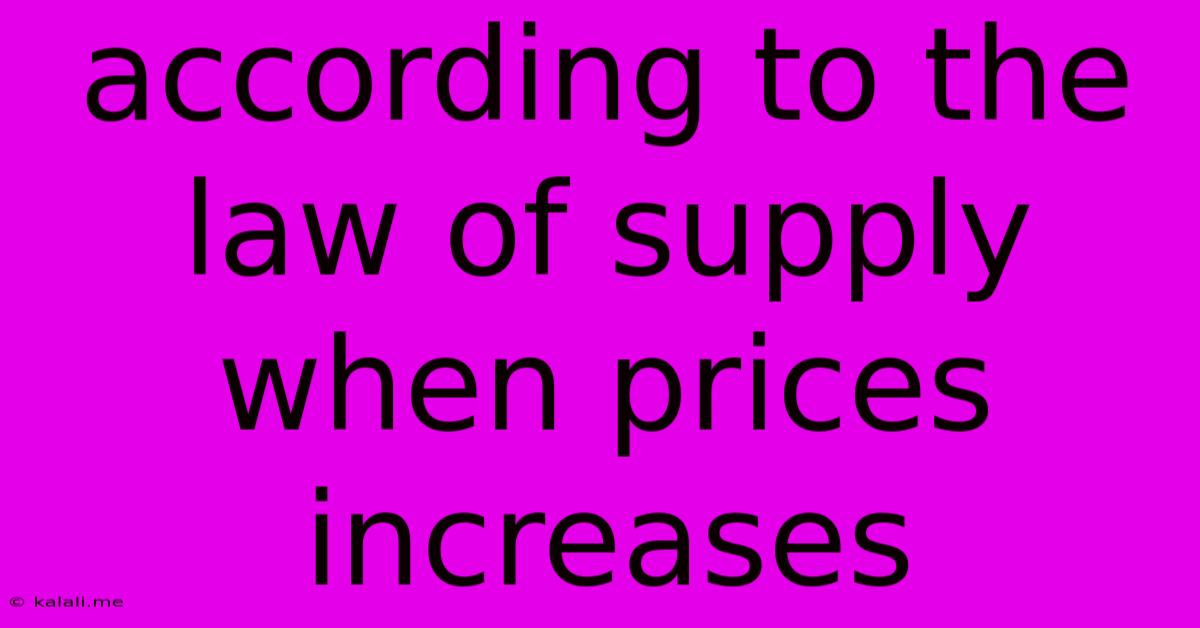According To The Law Of Supply When Prices Increases
Kalali
Jun 16, 2025 · 3 min read

Table of Contents
According to the Law of Supply: When Prices Increase
The law of supply is a fundamental principle in economics that describes the relationship between the price of a good or service and the quantity supplied. Simply put, as the price of a good increases, the quantity supplied of that good will also increase, ceteris paribus (all other things being equal). This article delves deeper into this relationship, exploring the underlying reasons and exceptions to this economic law. Understanding the law of supply is crucial for businesses making pricing decisions and for economists analyzing market behavior.
The Basic Principle: Higher Prices, Higher Supply
The law of supply reflects the incentive structure faced by producers. When prices rise, selling a product becomes more profitable. This increased profitability motivates existing producers to increase their output and attracts new producers to enter the market. This influx of goods and services leads to a larger quantity supplied at the higher price point. Consider a simple example: if the price of wheat increases, farmers will be incentivized to plant more wheat, potentially even investing in more land or equipment to maximize their profits.
This relationship isn't just about immediate increases in production; it's also about long-term adjustments. Higher prices signal to businesses that there's a greater demand for the product, justifying investments in expanding production capacity. This might involve hiring more workers, purchasing more machinery, or adopting more efficient production techniques.
Factors Influencing the Supply Curve
While the law of supply generally holds true, several factors can influence the shape and position of the supply curve. These factors, which are assumed constant under ceteris paribus, include:
- Input Prices: If the cost of raw materials, labor, or energy increases, it becomes more expensive to produce the good, potentially reducing the quantity supplied at any given price. This shifts the supply curve to the left.
- Technology: Technological advancements can lower production costs, making it more profitable to produce the good at any given price. This leads to an increase in supply, shifting the curve to the right.
- Government Regulations: Taxes, subsidies, and regulations can all impact the supply curve. For example, a tax on production will increase costs and reduce supply, while a subsidy will have the opposite effect.
- Producer Expectations: If producers expect prices to rise further in the future, they may choose to withhold some supply in anticipation of higher profits later. Conversely, if they anticipate price declines, they might increase supply in the present.
- Number of Sellers: An increase in the number of sellers in the market will increase the overall supply.
Exceptions and Limitations
While the law of supply is a reliable general principle, there are some exceptions. These typically arise from situations where the ceteris paribus assumption is violated. For instance:
- Perishable Goods: The supply of highly perishable goods, such as fresh fruit, might be less responsive to price changes in the short term because producers might be constrained by the limited shelf life of their products.
- Artistic Creations: The supply of unique, limited-edition art pieces might not increase significantly even if prices increase dramatically, as the artist's creative capacity and available time constrain the supply.
Conclusion: Understanding the Dynamic of Supply and Demand
The law of supply, alongside the law of demand, forms the bedrock of market analysis. Understanding how price changes affect the quantity supplied is crucial for making informed business decisions, predicting market trends, and comprehending the dynamics of supply and demand equilibrium. While the law operates with some exceptions, its fundamental principle remains a powerful tool for understanding how markets function. By analyzing the factors that shift the supply curve, businesses can anticipate and adapt to changes in market conditions and maintain a competitive edge.
Latest Posts
Latest Posts
-
How To Create Clickable Image In Html
Jun 16, 2025
-
What Are The Factors Of 121
Jun 16, 2025
-
What Is A Theme Of The Passage
Jun 16, 2025
-
A Company That Provides Access To The Internet
Jun 16, 2025
-
Which Word Is Closest In Meaning To The Underlined Word
Jun 16, 2025
Related Post
Thank you for visiting our website which covers about According To The Law Of Supply When Prices Increases . We hope the information provided has been useful to you. Feel free to contact us if you have any questions or need further assistance. See you next time and don't miss to bookmark.